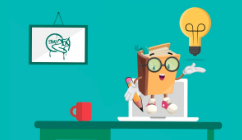
Digital Learning for Kids

Overview
e-Learning for Kids is an educational website for kids grades K-5. Lessons are organized by grade level as well as skill topics. Students can easily sort the lessons and then select the lesson they want to work on. They are guided through the lesson with a cartoon video-audio and prompts.
Learning Objectives
Students will:
- Be able to select a grade level lesson to complete.
- Be able to select from math, science, environmental skills, computer skills, language arts, health and life skills.
Vocabulary
Vocabulary Words:
-
Environment: The environment is the surroundings or conditions in which a person, animal, or plant lives or operates.
-
Skills: Skills are a particular ability.
-
Life Skills: Life skills are a skill that is necessary or desirable for full participation in everyday life.
Pre-planning
To prepare for this lesson:
-
The teacher introduces e-Learning for Kids to the class.
-
The teacher demonstrates the steps for the students to begin a lesson. The teacher may want to do one lesson as a whole class demonstration.
-
Help students select an appropriate level of a lesson.
Note: Headphones are needed if the whole class is participating at the same time.
Accommodations
See the Accommodations Page and Charts on the 21things4students website in the Teacher Resources.
Steps
Directions for this activity:
- Students log onto elearningforkids.org.
- Select the student icon.
- Select a topic.
- Select grade-level.
- Select a lesson to work on.
- When the screen opens, begin with the first box for the introduction to the lesson. Continue with the following boxes.
- The score will be displayed with earning stars.
Assessment Options
Different options for assessing the students:
- Observations
- Check for understanding.
- Exit ticket on what was learned.
- Share with the class on what was learned.
- Teacher observation.
MITECS Competencies & ISTE Standards
MITECS: Michigan adopted the "ISTE Standards for Students" called MITECS (Michigan Integrated Technology Competencies for Students) in 2018.
Empowered Learner
1a. Students articulate and set personal learning goals, develop strategies leveraging technology to achieve them and reflect on the learning process itself to improve learning outcomes.
1b. Students build networks and customize their learning environments in ways that support the learning process.
1c. Students use technology to seek feedback that informs and improves their practice and to demonstrate their learning in a variety of ways.
1d. Students understand the fundamental concepts of technology operations, demonstrate the ability to choose, use and troubleshoot current technologies and are able to transfer their knowledge to explore emerging technologies.
Devices and Resources
Device: PC, Chromebook, Mac, iPad
Browser: Chrome, Safari, Firefox, Edge, ALL
App, Extension, or Add-on:
Websites:
eLearning for Kids
CONTENT AREA RESOURCES
ELA
Students write in their language arts journal an example of what they learned. They explain it in their own words.
Integrated Arts
Students create posters of their lesson.
Math
Students write in their math journal an example of what they learned. They explain it in their own words.
Science
Students write in their science journal an example of what they learned. They explain it in their own words.
Social Studies
Students write in their S.S. journal an example of what they learned. They explain it in their own words.
CREDITS
This task card was created by Julie Hoehing, Lake Shore Public Schools, February 2020. Updated November 2023.


